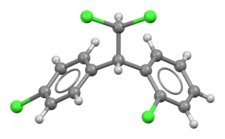Mitotane
 | |
 | |
| Clinical data | |
|---|---|
| Trade names | Lysodren |
| Other names | 1,1-(Dichlorodiphenyl)-2,2-dichloroethane; o,p'-DDD |
| AHFS/Drugs.com | Monograph |
| MedlinePlus | a608050 |
| License data | |
| Pregnancy category |
|
| Routes of administration | By mouth |
| ATC code | |
| Legal status | |
| Legal status | |
| Pharmacokinetic data | |
| Bioavailability | 40% |
| Protein binding | 6% |
| Elimination half-life | 18–159 days |
| Identifiers | |
| |
| CAS Number | |
| PubChem CID | |
| IUPHAR/BPS | |
| DrugBank | |
| ChemSpider | |
| UNII | |
| KEGG | |
| ChEMBL | |
| CompTox Dashboard (EPA) | |
| ECHA InfoCard | 100.000.152 |
| Chemical and physical data | |
| Formula | C14H10Cl4 |
| Molar mass | 320.03 g·mol−1 |
| 3D model (JSmol) | |
| Chirality | Racemic mixture |
| Melting point | 76 to 78 °C (169 to 172 °F) |
| |
| |
| (verify) | |
Mitotane, sold under the brand name Lysodren, is a steroidogenesis inhibitor and cytostatic antineoplastic medication which is used in the treatment of adrenocortical carcinoma and Cushing's syndrome.[2][3][4][5] It is a derivative of the early insecticide DDT and an isomer of p,p'-DDD (4,4'-dichlorodiphenyldichloroethane) and is also known as 2,4'-(dichlorodiphenyl)-2,2-dichloroethane (o,p'-DDD).[6]
Medical uses
Mitotane has been produced by Bristol Myers Squibb but it is marketed as an orphan drug for adrenocortical carcinoma due to the small number of patients in need of it. Its main use is in those patients who have persistent disease despite surgical resection, those who are not surgical candidates, or those who have metastatic disease. In a 2007 retrospective study of 177 patients from 1985 to 2005 showed a significant increase in the recurrence-free interval after radical surgery followed by mitotane when compared to surgery alone.[7] The drug is also sometimes used in the treatment of Cushing's syndrome.[4]
Side effects
The use of mitotane is unfortunately limited by side effects,[8] which, as reported by Schteinberg et al., include anorexia and nausea (88%), diarrhea (38%), vomiting (23%), decreased memory and ability to concentrate (50%), rash (23%), gynecomastia (50%), arthralgia (19%), and leukopenia (7%).[9]
Pharmacology
Pharmacodynamics
Mitotane is an inhibitor of the adrenal cortex. It acts as an inhibitor of cholesterol side-chain cleavage enzyme (P450scc, CYP11A1), and also of 11β-hydroxylase (CYP11B1), 18-hydroxylase (aldosterone synthase, CYP11B2), and 3β-hydroxysteroid dehydrogenase (3β-HSD) to a lesser extent.[2][8] In addition, mitotane has direct and selective cytotoxic effects on the adrenal cortex, via an unknown mechanism, and thereby induces permanent adrenal atrophy similarly to DDD.[10][11]
Chemistry
Analogues of mitotane include aminoglutethimide, amphenone B, and metyrapone.
History
Mitotane was introduced in 1960 for the treatment of adrenocortical carcinoma.[4]
Society and culture
Generic names
Mitotane is the generic name of the drug and its INN, USAN, BAN, and JAN.[5][12]
Brand names
Mitotane has been sold under the brand name Lysodren.[5]
Veterinary use
Mitotane is also used to treat Cushing's disease (pituitary-dependent Cushing's syndrome) in dogs. The medication is used in the controlled destruction of adrenal tissue, leading to a decrease in cortisol production.[13]
References
- ^ "FDA-sourced list of all drugs with black box warnings (Use Download Full Results and View Query links.)". nctr-crs.fda.gov. FDA. Retrieved 22 Oct 2023.
- ^ a b J. Larry Jameson; Leslie J. De Groot (18 May 2010). Endocrinology - E-Book: Adult and Pediatric. Elsevier Health Sciences. pp. 1888–. ISBN 978-1-4557-1126-0.
- ^ Hahner S, Fassnacht M (April 2005). "Mitotane for adrenocortical carcinoma treatment". Current Opinion in Investigational Drugs. 6 (4): 386–94. PMID 15898346.
- ^ a b c Marcello D. Bronstein (1 October 2010). Cushing's Syndrome: Pathophysiology, Diagnosis and Treatment. Springer Science & Business Media. pp. 156–. ISBN 978-1-60327-449-4.
- ^ a b c J. Elks (14 November 2014). The Dictionary of Drugs: Chemical Data: Chemical Data, Structures and Bibliographies. Springer. pp. 382–. ISBN 978-1-4757-2085-3.
- ^ Information from PubChem
- ^ Terzolo M, Angeli A, Fassnacht M, Daffara F, Tauchmanova L, Conton PA, Rossetto R, Buci L, Sperone P, Grossrubatscher E, Reimondo G, Bollito E, Papotti M, Saeger W, Hahner S, Koschker AC, Arvat E, Ambrosi B, Loli P, Lombardi G, Mannelli M, Bruzzi P, Mantero F, Allolio B, Dogliotti L, Berruti A (2007). "Adjuvant mitotane treatment for adrenocortical carcinoma". N Engl J Med. 356 (23): 2372–2380. doi:10.1056/NEJMoa063360. hdl:2318/37317. PMID 17554118.
- ^ a b Philip E. Harris; Pierre-Marc G. Bouloux (24 March 2014). Endocrinology in Clinical Practice, Second Edition. CRC Press. pp. 216–. ISBN 978-1-84184-951-5.
- ^ Schteinberg DE, Motazedi A, NoonanRA, Thompson NW (1982). "Treatment of Adrenal Carcinomas". Arch. Surg. 117 (9): 1142–1149. doi:10.1001/archsurg.1982.01380330010004. PMID 7115060.
- ^ Eudocia Quant Lee, MD, MPH; David Schiff, MD; Patrick Y. Wen, MD (28 September 2011). Neurologic Complications of Cancer Therapy. Demos Medical Publishing. pp. 179–. ISBN 978-1-61705-019-0.
{{cite book}}: CS1 maint: multiple names: authors list (link) - ^ C.R. Kannan (6 December 2012). The Adrenal Gland. Springer Science & Business Media. pp. 160–. ISBN 978-1-4613-1001-3.
- ^ Index Nominum 2000: International Drug Directory. Taylor & Francis. 2000. pp. 697–. ISBN 978-3-88763-075-1.
- ^ Canine Cushing’s Syndrome: Diagnosis and Treatment Archived 2007-10-21 at the Wayback Machine
External links
- V. P. Komissarenko; I. S. Chelnakova; A. S. Mikosha (1978). "Effect of o,p-dichlorodiphenyldichloroethane and perthane in vitro on glutathione reductase activity in the adrenals of dogs and guinea pigs". Bulletin of Experimental Biology and Medicine. 85 (2): 152–154. doi:10.1007/BF00800110. S2CID 23181221.
- Government of Canada: Benzene, 1-chloro-2-[2,2-dichloro-1-(4-chlorophenyl)ethyl]- (Mitotane)
- Environment Canada & Health Canada: RISK MANAGEMENT SCOPE for Benzene, 1-chloro-2-[2,2-dichloro-1-(4-chlorophenyl)ethyl]- (Mitotane), 2013
